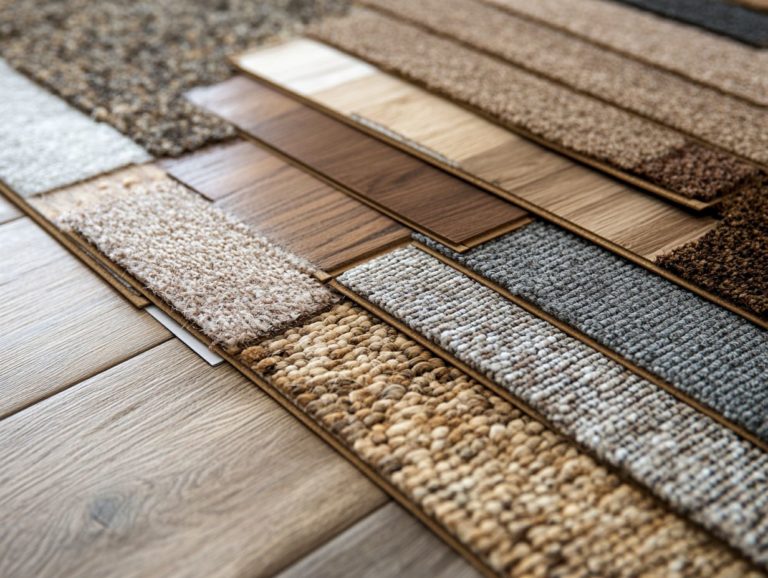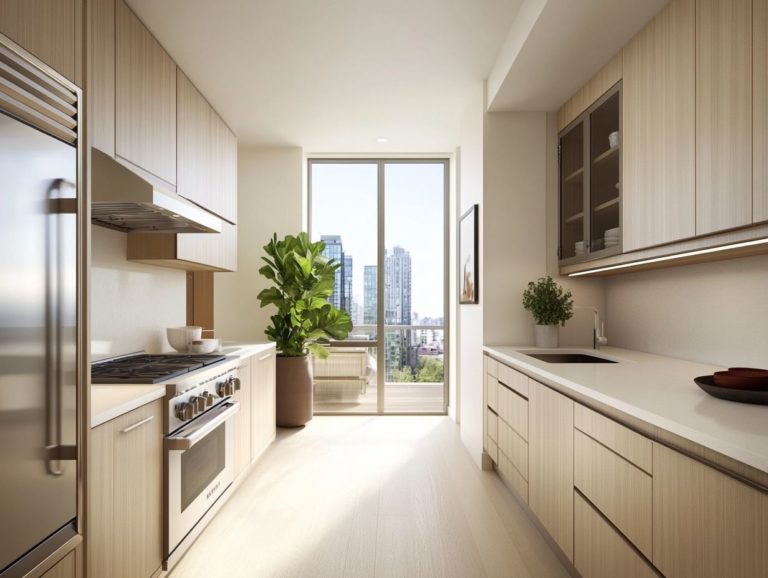5 Essential Tips for Selecting Kitchen Tiles
Choosing the right kitchen tiles can truly transform your space and enhance its functionality. With a multitude of options at your fingertips, it’s crucial to weigh several factors before settling on a decision.
Get ready to discover five essential tips that will change the way you choose kitchen tiles! This guide explores various materials, sizes, and maintenance considerations, helping you sidestep common pitfalls and curate a beautiful, durable kitchen.
Dive in to make informed choices for your culinary haven!
Contents
- Key Takeaways:
- 1. Consider the Function of the Kitchen
- 2. Choose the Right Material
- 3. Determine the Size of Tiles
- 4. Coordinate with Existing Design Elements
- 5. Think About Maintenance and Durability
- What Are the Different Types of Kitchen Tiles?
- How Can the Function of the Kitchen Impact Tile Selection?
- What Are the Pros and Cons of Different Tile Materials?
- How Can Tile Size Affect the Look and Function of a Kitchen?
- How Can One Choose Tiles That Complement the Existing Design?
- What Are Some Tips for Maintaining and Ensuring Durability of Kitchen Tiles?
- What Are Some Common Mistakes to Avoid When Selecting Kitchen Tiles?
- Frequently Asked Questions
- What are 5 essential tips for selecting kitchen tiles?
- How do I choose the right material for kitchen tiles?
- What size and shape of kitchen tiles should I choose?
- What should I consider for the color and pattern of kitchen tiles?
- How can I ensure my kitchen tiles are easy to maintain and durable?
- Is it important to stick to a budget when selecting kitchen tiles?
Key Takeaways:

Consider the function of your kitchen before selecting tiles to ensure they meet your needs and lifestyle.
Choose the right material for your kitchen tiles, taking into account factors such as durability, maintenance, and budget.
Determine the size of tiles based on the size of your kitchen and the desired look and function.
1. Consider the Function of the Kitchen
Before starting a kitchen renovation, think about how you use your kitchen. This will significantly influence your choices regarding design, tile selection, and the materials you ultimately choose for the wall area behind your kitchen sink or stove.
A thoughtfully designed kitchen enhances both aesthetics and functionality, ensuring the space meets the demands of your daily cooking while still looking undeniably stylish.
The kitchen is the heart of your home, where meals are prepared, memories are crafted, and families come together. Your activities—be it whipping up elaborate dinners, hosting lively gatherings, or navigating the morning breakfast hustle—will dictate your tile choices.
You might prefer durable porcelain that can withstand the occasional spill or textured ceramic that adds a touch of charm and grip. Opting for light-colored tiles can brighten your space and evoke a sense of openness, while darker hues can infuse warmth and sophistication.
Selecting tiles with subtle patterns can complement your cabinetry and countertops beautifully. This ties the entire aesthetic together while ensuring the tiles can handle the daily hustle and bustle of kitchen life.
2. Choose the Right Material
Choosing the right tile material is key. It ensures your kitchen is both durable and beautiful. You have a variety of options, from sturdy ceramic tiles to elegant glass tiles, each presenting unique characteristics and benefits.
The materials you select shape the overall look of your kitchen while influencing its maintenance and functionality. For example, porcelain tiles are celebrated for their durability, while mosaic tiles—small, colorful tiles arranged to create patterns or images—can inject vibrant colors and distinctive patterns that elevate your design.
Ceramic tiles, known for their affordability and wide array of styles, are a popular choice for floors and the wall area behind your kitchen sink or stove—just keep in mind that they may require sealing to resist stains.
Glass tiles can add a touch of modern flair and are ideal for creating eye-catching backsplashes, although their installation can be a bit tricky and they might not stand up well under heavy foot traffic.
On the other hand, stone tiles like granite and marble exude natural elegance on countertops; however, they often require regular sealing and maintenance to keep them looking their best.
Each tile type serves its own functional purpose while contributing to the kitchen’s overall aesthetic. Choose wisely to create the kitchen of your dreams!
3. Determine the Size of Tiles
Choosing the right tile size is key to designing your kitchen. It greatly affects both how the space looks and how you use it.
Larger tiles create a modern, seamless look. Smaller tiles allow for intricate patterns that add character.
In a small kitchen, larger tiles can make the area feel more open. They reduce the number of grout lines, giving a more spacious appearance.
Conversely, smaller tiles can highlight features like backsplashes. They draw the eye and enrich visual detail.
The tile arrangement also matters. A chevron pattern adds flair, while a grid layout offers balance.
The right combination of tile size and pattern improves your kitchen’s look. It creates a warm atmosphere you’ll enjoy spending time in.
4. Coordinate with Existing Design Elements
Coordinating your tile selection with the existing design elements in your kitchen is crucial for creating a stylish space that reflects your unique taste.
Whether you prefer modern tile styles or classic options, achieving harmonious color coordination between your backsplash tiles, countertops, and cabinets can elevate your kitchen’s decor.
Choose tiles that complement or contrast existing features to add a personal touch to your renovation.
Pay attention to the color temperature of your tiles. Warm tones pair beautifully with wooden cabinetry, while cool hues keep the space feeling fresh.
Incorporating textures and patterns that resonate with your overall design theme enhances the appeal. For example, a glossy subway tile creates depth against matte cabinets.
Staying informed about home decor trends can inspire choices that boost your kitchen’s visual appeal while ensuring timeless design.
5. Think About Maintenance and Durability

When selecting kitchen tiles, consider maintenance and durability. These factors influence the longevity and upkeep of your surfaces.
Durable options like porcelain or stone withstand high traffic and resist wear and tear.
Proper grout maintenance and cleaning are crucial for preserving the appearance of your tiles over time. Choosing practical tiles that are easy to clean ensures your kitchen remains beautiful and functional.
Ceramic tiles require minimal maintenance. Regular sweeping and occasional mopping with a mild cleaner suffice. In contrast, natural stone tiles may need sealing to prevent staining and can benefit from specialized stone cleaners.
Regularly cleaning and sealing grout joints is vital to prevent moisture buildup and discoloration, especially in kitchens prone to spills.
By opting for tiles that are not only visually appealing but also low-maintenance, you can create an inviting space without the stress of constant upkeep.
What Are the Different Types of Kitchen Tiles?
You’ll discover a stunning array of kitchen tiles, each with special features and looks that can truly elevate your kitchen’s design. From classic ceramic and durable porcelain to striking glass and charming stone tiles, understanding the various options available can profoundly influence the overall look and functionality of your space.
This knowledge enables you to select materials that perfectly align with your design preferences and practical needs.
Ceramic tiles stand out as a popular choice due to their affordability and low maintenance. They make a fantastic option for bustling kitchens.
If you need something even tougher, consider porcelain tiles. This resilient subtype of ceramic offers enhanced durability and moisture resistance, ideal for busy areas where lots of people walk.
For a splash of modern flair, glass tiles bring reflective surfaces that can brighten any room.
Stone tiles offer a unique, organic touch, albeit with a bit more upkeep.
Don’t overlook mosaic tiles, which are small pieces of tile used to create beautiful patterns. They’re perfect for backsplashes or accent walls, showcasing the remarkable versatility these materials bring to kitchen design.
How Can the Function of the Kitchen Impact Tile Selection?
The function of your kitchen plays a crucial role in guiding your tile selection. It helps you choose practical tiles that can withstand the demands of daily cooking and high-traffic areas.
Understanding how you’ll use the kitchen—whether it’s for family meals, entertaining guests, or serving as a workspace—will steer you toward the most suitable tile options that meet both your functional needs and aesthetic desires, all while keeping your budget in check.
For instance, if your kitchen is the hub for family gatherings, durable and easy-to-clean tiles like porcelain or ceramic could be your best allies. They handle spills and stains effortlessly while fostering a welcoming atmosphere.
On the flip side, if you’re a culinary enthusiast, you also have the option of using textured tiles that offer better grip and can withstand the rigors of frequent use, ensuring both safety and longevity.
Glossy tiles can work wonders in enhancing light reflection in spacious areas, creating the illusion of even more space.
Conversely, matte finishes might be just right for smaller, cozy kitchens where you want to cultivate a warm and intimate feel.
Finding the right balance between these practical considerations and your design vision will create a cohesive yet functional kitchen environment that truly reflects your style.
What Are the Pros and Cons of Different Tile Materials?
Each type of tile material presents its own distinct set of advantages and disadvantages. These can significantly impact your decision-making when renovating your kitchen.
From the affordability of ceramic tiles to the luxurious appeal and durability of high-end stone tiles, understanding these nuances enables you to make informed choices that harmonize with both your design ambitions and practical needs.
Take ceramic tiles, for example. They’re not just budget-friendly; their versatility makes them perfect for a range of design styles, from sleek modern aesthetics to charming rustic kitchens.
However, keep in mind that they may be more prone to chipping or cracking than their stone counterparts.
Stone tiles, while often pricier, can endure heavy use and infuse your space with an undeniable elegance.
On the other hand, glass tiles can truly illuminate your kitchen and are a breeze to clean. Just be prepared for a slightly higher investment and the need for regular maintenance to maintain their pristine appearance.
By thoughtfully weighing these pros and cons, you can select materials that align with your budget, style preferences, and maintenance readiness.
How Can Tile Size Affect the Look and Function of a Kitchen?
Tile size significantly influences both the aesthetic and functional aspects of your kitchen. It affects everything from the perception of space to installation and maintenance ease.
Opting for larger tiles can create a modern and spacious feel. In contrast, smaller tiles allow for unique patterns, adding visual interest to your design.
When considering your kitchen dimensions, larger tiles help minimize grout lines, enhancing a seamless appearance and making cleaning easier.
Smaller tiles also offer flexibility to craft intricate designs or fit snugly around irregular spaces. However, be aware that they may require more time during installation due to the greater number of pieces involved.
Ultimately, choosing the right tile size means evaluating your layout and personal design ambitions to ensure your selections align with both practicality and your style preferences.
How Can One Choose Tiles That Complement the Existing Design?

Choosing tiles that complement the existing design elements in your kitchen is crucial for a cohesive and visually appealing space. You want the selected materials to harmonize beautifully with features like cabinetry, countertops, and decor.
By focusing on color coordination and tile styles, you can elevate the kitchen’s aesthetics, creating an inviting atmosphere that showcases your taste while highlighting stylish tiles.
Start by identifying standout features in your kitchen that deserve attention—think unique lighting fixtures or appealing countertop textures. Pay close attention to the overall color palette: neutral tones work wonders with vibrant tiles, while bold cabinetry calls for more subdued or patterned choices.
Different tile materials, like clay-based tiles, hard tiles made from sand, or tiles made from natural rocks, can significantly enhance your kitchen design. Selecting tiles that resonate with both style and functionality will lead to a harmonious outcome.
What Are Some Tips for Maintaining and Ensuring Durability of Kitchen Tiles?
Maintaining the durability of your kitchen tiles requires a keen understanding of proper maintenance practices. Make sure your tiles stay stunning with these easy tips!
Adopting effective cleaning tips and grout maintenance techniques not only preserves the visual appeal of your tiles but also extends their lifespan, especially in high-traffic areas.
For routine cleaning, use warm water mixed with a few drops of mild dish soap. Don’t forget to seal the grout every six months; this quick step is essential to protect against staining and moisture!
If you have natural stone tiles, like marble or granite, opt for pH-balanced cleaners and remember to seal them periodically to maintain their stunning luster.
Porcelain tiles are resilient, but they still need care—clean them with a soft brush and either vinegar or specialized tile cleaners. Plus, using mats in entryways can prevent dirt and grit from scratching your beautiful surfaces.
Emphasizing these preventive measures will keep your kitchen looking pristine. Try out these tips to make a difference!
What Are Some Common Mistakes to Avoid When Selecting Kitchen Tiles?
Selecting kitchen tiles can be tricky. Avoid common mistakes that can hurt both the look and use of your kitchen.
Think about how your kitchen will be used. Don’t rush into trendy materials that may not last.
Choose tiles not just for how they look. Consider their durability and maintenance, as well as safety features like slip resistance.
Make sure your tile selection matches your cabinetry, countertops, and appliances. This creates a cohesive look and enhances functionality.
Keep your budget in mind to make smart choices. This helps ensure your kitchen design is both beautiful and practical.
Frequently Asked Questions
What are 5 essential tips for selecting kitchen tiles?
Here are five essential tips: consider the material, size and shape, color and pattern, maintenance and durability, and your budget.
How do I choose the right material for kitchen tiles?

Your choice of material depends on your budget and style. Popular options include ceramic, porcelain, natural stone, and glass tiles.
What size and shape of kitchen tiles should I choose?
The size and shape should fit your kitchen’s overall design. Larger tiles can make a small kitchen seem bigger, while smaller tiles are perfect for intricate patterns.
What should I consider for the color and pattern of kitchen tiles?
Choose colors and patterns that enhance your kitchen’s look. Neutral colors like white and beige are versatile, while bold patterns can add flair.
How can I ensure my kitchen tiles are easy to maintain and durable?
Opt for stain-resistant tiles that are easy to clean. Porcelain and ceramic are great choices for areas with heavy foot traffic.
Is it important to stick to a budget when selecting kitchen tiles?
Yes, having a budget helps narrow down your choices and prevents overspending. Remember to include installation costs in your budget.





